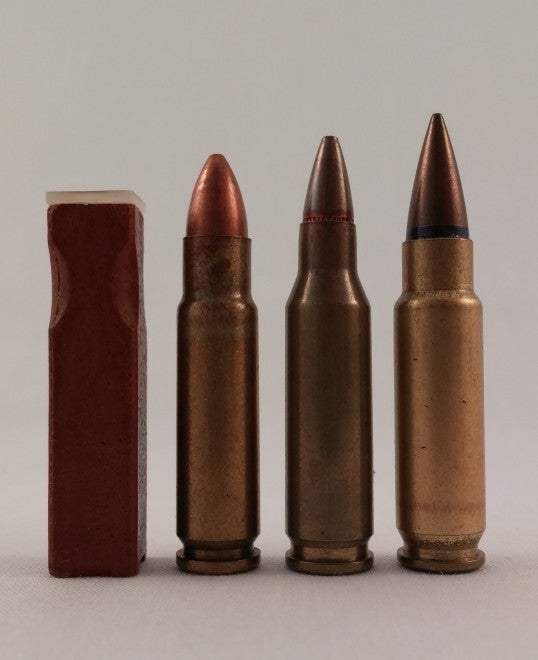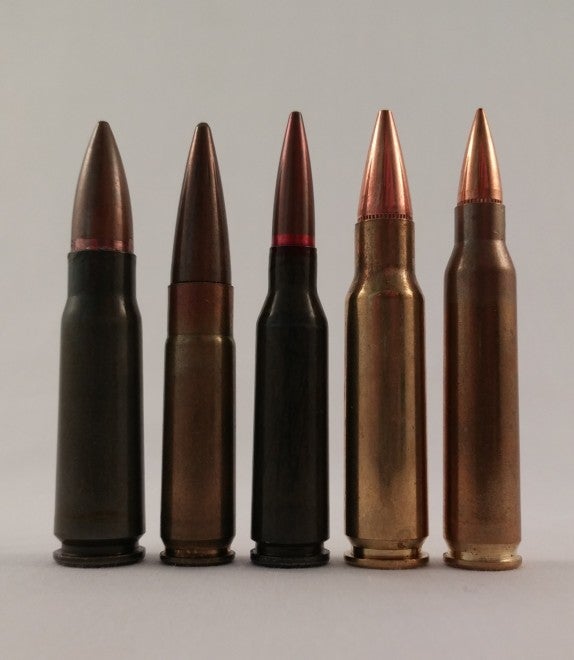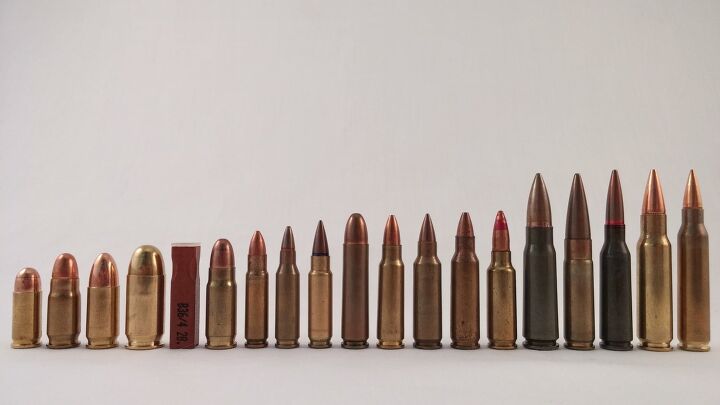Last month, I featured a couple of photos from British gun author Anthony Williams, which showcased some of the major developments in PDW ammunition in the last century. While his collection certainly beats mine for completeness, I still figured it would be worthwhile to share a photo of some of the PDW rounds I’ve accumulated over the past few years since I began collecting:
From left to right:
- 32 ACP, used in the vz. 61
- 7.65x22mm Parabellum, used in the 1902 Luger Carbine
- 9x19mm Parabellum, used in many SMGs and PDWs
- .45 ACP, included here chiefly for the M3 Grease Gun’s use as a PDW
- 4.7x33mm, although the G11 was not a PDW, there was a design called the H&K G11 PDW that used a shortened, reduced-power 25mm long version of the 4.7×33, and because so far as I know no examples of this ammunition exist, I am including it
- 7.63x25mm Mauser, used in the Mauser 712 “Schnellfeuer” and other fully automatic Mauser derivatives. Dimensionally identical to the more common 7.62×25 Tokarev, itself used in PDWs
- .22 SCAMP, used in the Colt SCAMP SCHV machine pistol PDW
- 4.6x30mm HK, used in the MP7
- 5.7x28mm SS190 AP, used in the FN P90
- .30 Carbine, used in the M1 Carbine
- 5.7x33mm Spitfire (high velocity test nylon-cored projectile), developed by Melvin Johnson to improve the performance of the M1 Carbine
- .22 APG Carbine, the first modern small caliber high velocity round, developed by G. A. Gustafson for use in retrofitted M2 Carbines
- .22 High Velocity, a test round loaded with an aluminum-cored projectile based on the .221 Fireball and very similar to ammunition loaded for the Colt IMP which later inspired the Bushmaster Arm Pistol
- 5.56x30mm Colt MARS (tracer), developed by Colt for a shortened AR-15 derived PDW similar in concept to the later KAC PDW
- 7.62x39mm, used in several PDWs both production an ad-hoc, notably the Serbian Zastava M92
- .300 AAC Blackout, used in several AR-15-derived PDWs, most notably the AAC Honey Badger
- 5.45x39mm, used in the AKS-74U subcarbine/PDW, and other compact assault rifles
- 6.8x43mm Remington SPC, not traditionally thought of as a PDW cartridge, the only formal adoption of this round was by the Jordanian Royal Guard, who purchased LWRC PSDs
- 5.56x45mm SS109, used in many PDWs including the Bushmaster Arm Pistol and the experimental Magpul PDR
Below are some higher detail photos of these rounds, in four groups:

Pistol rounds: .32 ACP/7.65 Browning, 7.65x22mm Parabellum, 9x19mm Parabellum, .45 ACP, 7.63x25mm Mauser

Small caliber machine pistol rounds: 4.7x33mm HK (standing in for 4.7x25mm HK), .22 SCAMP, 4.6x30mm HK, 5.7x28mm FN

Subcarbine rounds: .30 Carbine, 5.7x33mm Johnson Spitfire, .22 APG Carbine, .221 High Velocity, 5.56x30mm MARS

Assault rifle rounds used in subcarbines: 7.62x39mm, .300 AAC Blackout, 5.45x39mm Soviet, 6.8x43mm Remington SPC, 5.56x45mm NATO
To take these photos, I made a photographer’s light box out of foam core and fabric, materials that cost me about $35. If you want to make your own light box so you can take evenly lit, diffused photos of your own, I’ve embedded a tutorial below by the channel DIY Trying:
A 20″x20″ light box like the one I made is the perfect size for taking photos of cartridges, handguns, and other small objects. Even if you just regularly have to take photos of guns you’re selling on GunBroker, a light box can really make the object look great.
 Your Privacy Choices
Your Privacy Choices
